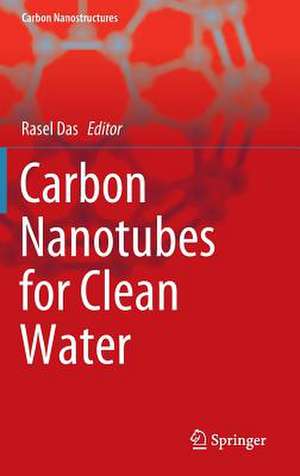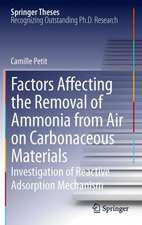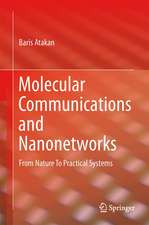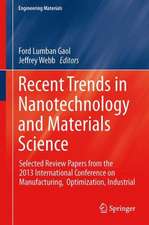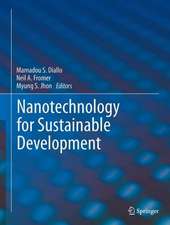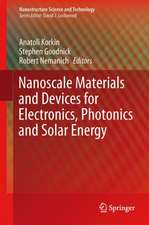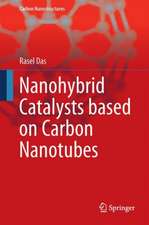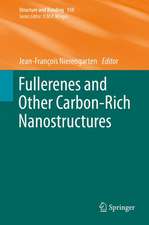Carbon Nanotubes for Clean Water: Carbon Nanostructures
Editat de Rasel Dasen Limba Engleză Hardback – 21 aug 2018
| Toate formatele și edițiile | Preț | Express |
|---|---|---|
| Paperback (1) | 721.95 lei 6-8 săpt. | |
| Springer International Publishing – 25 ian 2019 | 721.95 lei 6-8 săpt. | |
| Hardback (1) | 1000.24 lei 6-8 săpt. | |
| Springer International Publishing – 21 aug 2018 | 1000.24 lei 6-8 săpt. |
Din seria Carbon Nanostructures
- 15%
 Preț: 655.60 lei
Preț: 655.60 lei - 18%
 Preț: 1217.27 lei
Preț: 1217.27 lei - 5%
 Preț: 715.91 lei
Preț: 715.91 lei - 15%
 Preț: 634.32 lei
Preț: 634.32 lei - 15%
 Preț: 637.59 lei
Preț: 637.59 lei -
 Preț: 385.84 lei
Preț: 385.84 lei - 18%
 Preț: 953.97 lei
Preț: 953.97 lei - 18%
 Preț: 724.29 lei
Preț: 724.29 lei - 15%
 Preț: 640.06 lei
Preț: 640.06 lei - 15%
 Preț: 646.30 lei
Preț: 646.30 lei - 18%
 Preț: 949.73 lei
Preț: 949.73 lei - 15%
 Preț: 632.70 lei
Preț: 632.70 lei - 18%
 Preț: 999.76 lei
Preț: 999.76 lei - 18%
 Preț: 1393.72 lei
Preț: 1393.72 lei - 18%
 Preț: 951.14 lei
Preț: 951.14 lei - 18%
 Preț: 725.13 lei
Preț: 725.13 lei
Preț: 1000.24 lei
Preț vechi: 1219.81 lei
-18% Nou
Puncte Express: 1500
Preț estimativ în valută:
191.42€ • 207.85$ • 160.79£
191.42€ • 207.85$ • 160.79£
Carte tipărită la comandă
Livrare economică 22 aprilie-06 mai
Preluare comenzi: 021 569.72.76
Specificații
ISBN-13: 9783319956022
ISBN-10: 3319956027
Pagini: 306
Ilustrații: VII, 186 p. 60 illus., 54 illus. in color.
Dimensiuni: 155 x 235 mm
Greutate: 0.45 kg
Ediția:1st ed. 2018
Editura: Springer International Publishing
Colecția Springer
Seria Carbon Nanostructures
Locul publicării:Cham, Switzerland
ISBN-10: 3319956027
Pagini: 306
Ilustrații: VII, 186 p. 60 illus., 54 illus. in color.
Dimensiuni: 155 x 235 mm
Greutate: 0.45 kg
Ediția:1st ed. 2018
Editura: Springer International Publishing
Colecția Springer
Seria Carbon Nanostructures
Locul publicării:Cham, Switzerland
Cuprins
Introduction.- Water Pollutants Classification and its Effects on Environment.- Carbon Nanotubes Synthesis.- Adsorption.- Catalysis.- Membrane Technology.- Disinfection.- Sensing and Monitoring.
Notă biografică
Dr. Rasel Das is a Postdoctoral Research Fellow at the Leibniz-Institute of Surface Modification (IOM), Leipzig, Germany, as well as a Consultant in Water Desalination and Transport Division for MHD Technology Corp. NY, USA.
Textul de pe ultima copertă
This book presents carbon nanotubes as a potential material for the development of new waste water treatment technologies. Reviews on adsorption, catalysis, membrane, filtration and desinfection methods are provided. A special chapter presents the use of carbon nanotubes to sense and monitor water pollutants. The text underlies each technology and process as well as the current commercialization efforts. Research gaps are highlighted at the end with links to further reading material in the field.
Caracteristici
Focuses on carbon nanotube-based water treatment technologies Underlies the current commercialization efforts in the field Features a special chapter on nanotubes for sensing and monitoring water pollutants
